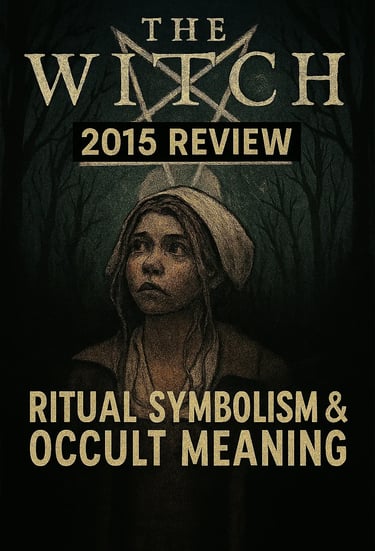The Witch 2015 Review — Ritual Symbolism
The Witch 2015 review decoding ritual symbolism and occult meaning for altar‑makers and collectors — scene analysis, altar prompts, and merch‑ready takeaways.
HORROR REVIEWS
Marcel Helmar
10/6/20257 min read


This "The Witch (2015) review" decodes ritual symbolism and occult meaning—reads the film as liturgy; watch it like a rite. Robert Eggers’ The Witch arranges gestures, objects, and silences into a slow‑burning sacrament rather than handing you jump scares.
Read this piece as a devotional map for image, sound, and craft: scene‑level readings you can translate into altars, soundscapes, and collector pieces. If you make ritual art or merch, consider this a practical guide to the film’s textures, symbols, and the occult meanings that give them charge.
Ritual Atmosphere and Cinematic Prayer
Eggers composes images like a carpenter setting joints. The camera frames people against negative space as if each human were a relic in a reliquary. The film’s tempo is deliberate; dialogue reads like confession, not conversation, and silence becomes a working liturgy. The result is not a list of shocks but a topology of dread where every material detail carries doctrinal weight.
The world of The Witch is a domestic chapel under strain. Textures function as scripture: homespun linen, soot-darkened wood, and lamp oil smell are not mere production flourishes; they are semantic markers that teach the viewer how to read the scene. The austerity of the mise-en-scène forces attention to the small rituals—prayers before bread, the measuring of seed, the cutting of hair—which double as liturgical acts and narrative pivots.
Visually the film privileges negative space and painterly compositions. Wide, static shots drain cinematic convenience and force the viewer into a posture of sustained attention. This posture mirrors the Puritan household’s constant rehearsal of doctrine: repetition, attention, and the terrifying demand that a single misstep might mean damnation. The aesthetic is not sentimental; it is a forensic romance with texture.
Caption: The girl listens; the world answers in ritual and omen.
From Screen to Altar — Record The Witch’s Textures for Study and Ceremony
Record the Barn Scene — compact field recorder to capture wind, hearth, and animal textures for ritual soundscapes, scene study, and altar practice.


$39.99 - Amazon
Plot Bones and Who They Serve
Set in 1630s New England, the film follows a family exiled from their congregation who set up a homestead on the ragged edge of the wilderness. The father’s piety is brittle and performative, the mother’s grief quiet and dense, the older siblings tasked with labor that leaves them thin with worry, and Thomasin, the adolescent, stands at an axis of desire, accusation, and possible transformation.
The narrative moves like a ritual timetable: an infant disappears, crops fail, animals behave oddly, accusations are cast. Each failure is read through a theological lens that insists on supernatural culpability. That insistence turns social processes—fear, scapegoating, gendered control—into metaphysical verdicts. The family’s interpretive framework cannot tolerate ambiguity; where the modern mind sees contingency, Puritan logic must name a culprit.
Thomasin’s arc is the story’s sacramental problem. There is no tidy answer about agency. Does she connive, or is she swept into a different ontology? Eggers refuses to privilege one reading. The camera offers evidence and silence in equal measure, and the result is an ethical mirror: what systems do when they cannot explain misfortune, and who pays the price.
Ritual Symbolism Scene by Scene
The film stages belief as material practice: bonnets, hearth tools, animal bodies, and the barn become nodes in a lived cosmology. In this The Witch (2015) review—ritual symbolism and occult meaning—I track how recurrent motifs (the bonnet, the clearing, Black Phillip) function as talismans, scapegoats, and thresholds. Close shots of hands, linen, and ritual gestures compress moral logic into tangible signs; each prop carries indexical weight that the camera turns into doctrine. Read the sequences as ceremonial steps rather than plot beats, noting how mise‑en‑scène encodes temptation, exile, and covenant rupture.
The Bonnet and Linen Clothing in the film is a semiotic system. Bonnet and homespun linen insist on modesty and a social grammar where the body is a text to be read and policed. When clothing becomes stained, ragged, or ill-fitting, it signals interior fracture. For collectors and costumers, the austerity of garment details here is instructive: thread tension, hand-sewn seams, and the slow matte of aged linen are the materials of authenticity.
Seeds and Harvest Failure The family’s seeds are covenantal objects. Their failure is an index of breached promise. In ritual terms, the seed is a material prayer; when the harvest fails, the visible economy of meaning collapses. For altar work, consider seeds as both emblem and medium—seed jars, sown bundles, and offerings that mark the fragile economy between human labor and cosmic provision.
The Goat Black Phillip Black Phillip is an altar and a pivot. Goats occupy a liminal taxonomy: domesticated and wild, useful and subversive. In the film, the goat functions as scapegoat, tempter, and mirror. Its presence externalizes repressed desire and functions as the narrative’s invitation to a counter-order. For merch and ritual objects, the goat offers a visual shorthand—pinned enamel designs, pressed sigils on cards, or small sculpted votives that carry the film’s ambivalence.
Mirrors and Reflections Mirrors are scarce and therefore charged. When anything approximating a reflection appears, it signals doubleness: the self split, a secret revealed. A mirror, even an imperfect one, can be a powerful prop in altar photography and limited-edition merch, where reflection becomes metaphor and practice.
The Forest as Other Rule The wood is not just scenery; it is a juridical space where other rules apply. The forest’s silhouette becomes a kind of topography of desire and danger. For ritual artists the forest image suggests threshold work: liminal offerings left at edges, charcoal maps, and sound collages that sample wind and twig-crack.


Altar Apparel Feature — Flesh Catechism Release.
Devour the image, keep the altar—Flesh Catechism, heavy‑ink ritual apparel for collectors.
$22.50
Language, Performance, and Tonal Mechanics
Eggers insists on archaic diction as a formal device. The dialogue’s cadence is incantatory: words land as if on an altar. That choice is not antiquarianism; it performs a distance that amplifies thematic stakes. Actors do not explain; they intone, and small vocal inflections are moral indexes.
Performances are economy of gesture. The most violent moments are often silent, and the camera lingers on hands, posture, and the way breath fogs cold air. Thomasin’s ambiguity is essential: she is not a cipher, but a nexus. Her choices function less as plot points and more as altar acts that reverberate through family theology.
As a reader and ritual-maker, attend to diction and gesture. Transcribe lines that hang in the air and rehearse them as liturgical fragments. Use small gestures as durational practice: repeating a hand motion, wearing a bonnet for a single hour, or preserving a scrap of linen as a talisman. These micro-practices translate cinematic effect into embodied ritual.
Black Phillip and the Ethics of Temptation
Black Phillip’s voice at the film’s end is a pivot from accusation to offer. The goat does not merely command; it promises an alternate sovereignty. That promise reframes rebellion as a type of autonomy, attractive because it offers agency where doctrine offers only submission. The ethical paradox is the film’s thrum: is freedom worth the cost of covenant rupture?
For creatives the goat is a perfect device: visually iconic, narratively ambiguous, and culturally resonant. Use Black Phillip as a symbol that resists simple merchandising exploitation. When placing merch or affiliate products, frame objects as tools for practice and reflection rather than trivialized iconography. A Black Phillip enamel pin is less effective as ornament than as an altar token accompanied by a short ritual text.
From Screen to Altar — Practical Takeaways
Translate the film’s textures into practice without flattening meaning: collect linen, distressed wood, and a single dark‑fur figure to build altars that echo The Witch’s economy of sign. This The Witch (2015) review—ritual symbolism and occult meaning—offers concrete prompts: recreate the barn’s negative space with candle placement to mimic chiaroscuro; use field recordings of wind and hearth to build a ritual soundscape; design limited merch that emphasizes tactile distress and numbered runs to mirror the film’s archival intimacy. These are ways to honor the film’s occult grammar while making work that feels like an extension of its ritual logic.
FAQs
Question: Does The Witch use real rituals? Answer: Eggers consulted period sources and reconstructed domestic rites and beliefs to create ritual accuracy while using cinematic invention for dramatic effect.
Question: What does Black Phillip represent? Answer: Black Phillip functions as both scapegoat and tempter, a liminal figure that reframes doctrinal obedience as a choice and embodies repressed desire.
Question: Is The Witch historically accurate? Answer: The film captures the epistemic logic of 17th-century Puritan life with high fidelity in language, costume, and ritual practice while compressing and fictionalizing events for thematic focus.
Question: Which scenes are most useful for altar inspiration? Answer: The barn sequences, the bonnet and linen details, and the final clearing scene are most rich for material translates into altar art and soundscapes.
Question: Where should I buy authentic props and companion texts? Answer: Purchase archival reprints, period herb packs, and small-batch artisanal objects from specialist vendors and vetted affiliate partners that emphasize craft and provenance.
Question: Does this The Witch (2015) review explain ritual symbolism and occult meaning? Answer: Yes — this review decodes the film’s ritual imagery and offers practical altar and merch prompts.
Join Us, Start the Ritual
Subscriber‑only short story, behind‑the‑scenes art, and priority access to limited releases — refined, rare, monthly.
About the Author:
Marcel Helmar is a cinematic occult artist, writer, and founder of Horror & Hexes. His work blends ritual symbolism, folk horror, and studio‑grade printmaking to produce limited art drops, immersive essays, and practical ritual guides.
Marcel’s writing and visual practice have been used by filmmakers, podcasters, and indie publishers to create atmosphere and authenticity; he teaches workshops on image making, lore research, and publishing for dark‑culture creators. Visitors can browse his gallery, read deep‑dive essays, or join the mailing list for exclusive drops and process notes.
Connect
Explore dark tales and ritualistic mysteries here.
Support
+1-337-718-0155
© 2025. All rights reserved.
Flesh Catechism T-Shirt
Eat Your Heart Out
$22.50
